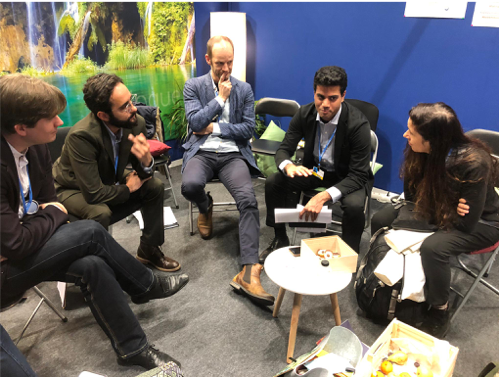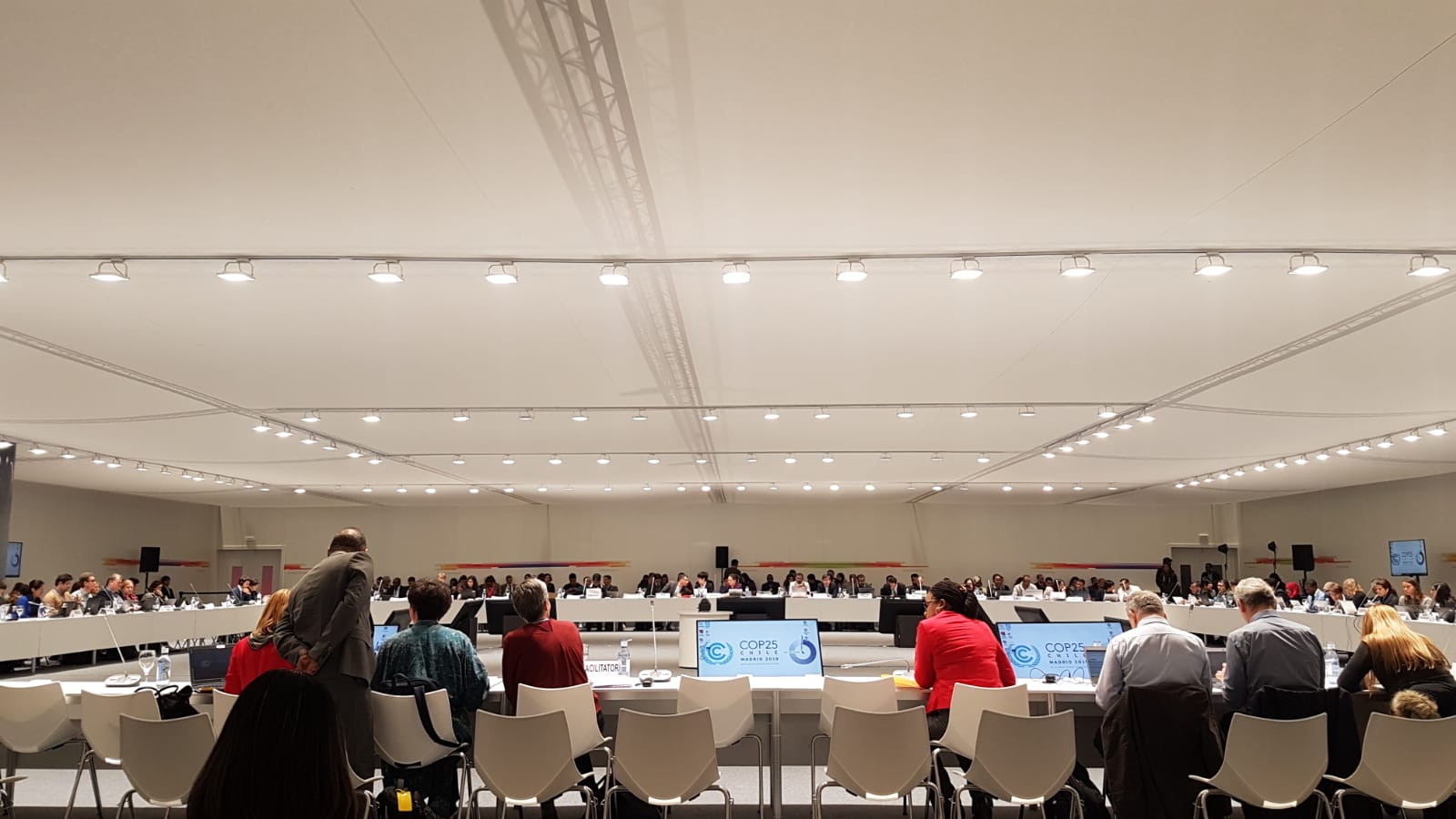Youth-inclusive climate finance
As a University of Waterloo delegate at COP25 and through my work with Youth Climate Lab, a global non-profit organization focused on accelerating youth-led ideas, projects and businesses that tackle climate change, I received an opportunity to host a guest session at the Institute for Advanced Sustainability Studies’ (IASS) Co-Creative Reflection and Dialogue Space. I spoke to and discussed with other delegates from Switzerland, Brazil, the United Kingdom, and Germany on how impact investing initiatives can address climate change solutions with youth-inclusive climate finance. Here are some of the highlights from the discussion!

Young people are at the forefront of climate action, driving practical solutions in their cities, communities, neighbourhoods and families. They represent the demographic most affected by climate change, yet have been historically disempowered to scale their solutions. Youth-led solutions can be high-reward, low-cost approaches to mobilizing climate action at local levels, while simultaneously cultivating an ecosystem of green entrepreneurs at the forefront of the upcoming generation’s clean economy boom.
Current climate finance has largely been unsuccessful in reaching the most poor and vulnerable communities. In response, intersectional and inclusive approaches to evaluating investment and granting decisions have begun to emerge. Despite this recent and growing effort, the youth demographic, one disproportionately affected by climate change far greater than any other, remains under-considered and under-funded.
By definition, impact investing is when investments are made into companies, organizations, and funds with the intention to generate positive social and environmental impact alongside a financial return (Harji, Reynolds, & Best, 2014). Impact investing challenges both of the long-held views that social and environmental issues should be addressed only by philanthropic donations, and that market investments should focus exclusively on achieving financial returns.
You can clearly see young people everywhere at the events, pavilions, negotiations, and other spaces at COP25. They are coming from universities, non-profit organizations that they have started, they are participating in programs, and internships, and creating their own projects. Many of them are funding their own way. Their efforts back home are also largely under-financed. Young people today have immense ambition and generally work on smaller scale projects within smaller groups and communities, that do not have the same level of access to financing for their work compared to big projects that the Green Climate Fund or a bank may finance.
Youth Climate Lab works with young people around the globe and are exploring how to better support youth-led efforts through financing. We are conducting research on youth-inclusive climate finance through a policy workshop at the UN Youth Climate Action Summit not long ago, a literature review, online surveys of climate entrepreneurs, and targeted interviews with global youth and experts. What we have learned so far is that there are many financial setbacks that relate to the challenges and gaps youth face when trying to achieve action and pursue solutions on climate change.
With this in mind, it is clear that investments in environment are closely linked to poverty, hunger, and health which are challenges that the youth of today are unfairly extremely vulnerable to, especially given that they have inherited the burden of the climate emergency (Sachs & Reid, 2006). On top of this, it is evident that the financial sector has the power to invest in solutions that positively affect the environment and society, while meaningfully contributing to sustainable development. Impact investing methodology poses innovative new approaches to investment and financing models that can allow youth to persevere in climate action.
Resilience
Currently widely reported in world news, the outcomes of the United Nations’ climate negotiations at COP25 were less than ideal to say the least. This year’s negotiations did not start off on the right note either, with the president of Chile announcing they would not be able to host the event due to the country’s serious anti-government protests in Santiago.
Luckily, a move to Madrid within days of Chile’s cancellation saved COP25 and allowed it to be held on the exact same dates intended. As the negotiations progressed, it became apparent most nations were not taking COP25’s motto, “tiempo de actuar”or “time for action”, very seriously. Unfortunately and ultimately, a consensus was not reached in many different areas of the negotiations and most decisions have been postponed to next year. However, I still feel there is hope for the state of climate negotiations and global progress on the climate crisis.
Perhaps my source of hope for climate progress comes from a recurring theme of resilience in my own life, yet I feel my experience and exposure at COP25 allowed me to witness a groundswell of action from actors other than governments. COP25, and the UNFCCC COPs in general, are organized with a variety of sections and have many attendees from organizations around the world. There are negotiations, side events, pavilions, civil society meetings, press conferences, and even protest actions by attendees to put further pressure on governments. Beyond the layout of the COP25 space, the attendees are made up of government delegations and representatives, civil society members, non-governmental organizations, educational institutions, universities, research institutes, private sector organizations, amongst many more.

All of the events, meetings, and presentations that occur outside of the negotiation process illustrate climate action is being conducted in many different places. While the history of the UN climate process has always placed focus on negotiations between governments, there was a light shone on the many environmental and social initiatives being carried out globally by communities, private sector, non-profits, and other groups. On top of this, the UN’s Sustainable Development Goals have been deeply embedded in the minds of anyone working within the realm of sustainability and climate change. I believe these initiatives, that are external to the work of governments, highlight a deeper level of resilience within our society that is typically not reported in media and generally not discussed amongst us. Not to mention that 60-75 years ago, it would have been next to impossible to have every country in the world sitting at the same table, in one room, trying to discuss and achieve international cooperation on a single issue. If anything, my one take away from attending COP25 is that action needs to happen from every facet of our society for progress to be made on climate change. Better yet, there is clear evidence that pockets of action are emerging at all levels of society.
As a student in the University of Waterloo’s Faculty of Environment, both during my undergraduate degree and currently in my master’s degree, it is quite disheartening to see the world’s governments fail to collaborate on the most urgent issue of our time. Despite the negative outcomes from COP25, the growing loss of faith in the UN climate process, and the level of inaction from government, I still have hope and believe that a certain level of resilience is required within all of us to ensure progress is made from other fronts. It is time for all of us to act – tiempo de actuar.
References:
Harji, K., Reynolds, J., Best, H. (2014). Impact investing in canada. Retrieved December 5, 2019, from https://www.marsdd.com/wp-content/uploads/2014/09/Impact-Investing-in-Canada-State-of-the-Nation-2014-EN.pdf
Sachs, J. D., & Reid, W. V. (2006). Investments Toward Sustainable Development. Science, 312(5776), 1002.

Muhammad isa graduate student in the Master of Environmental Studies, Sustainability Management program. He attended COP25 United Nations Climate Change Conference in Madrid, Spain during fall 2019. This is his reflection from participating as a student delegate.